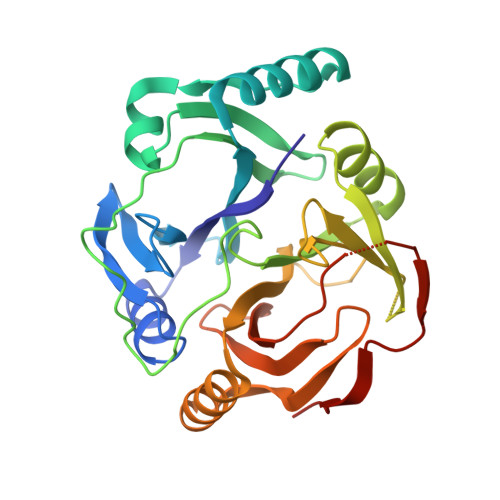Three-dimensional structures of free form and two substrate complexes of an extradiol ring-cleavage type dioxygenase, the BphC enzyme from Pseudomonas sp. strain KKS102.
Senda, T., Sugiyama, K., Narita, H., Yamamoto, T., Kimbara, K., Fukuda, M., Sato, M., Yano, K., Mitsui, Y.(1996) J Mol Biol 255: 735-752
- PubMed: 8636975
- DOI: https://doi.org/10.1006/jmbi.1996.0060
- Primary Citation of Related Structures:
1DHY - PubMed Abstract:
The crystal structure of an enzyme having polychlorinated-biphenyl degrading activity, the BphC enzyme from Pseudomonas sp. strain KKS102, has been solved as a free form at 1.8 A resolution. This is the first three-dimensional structure among the extradiol-type dioxygenases. Based on 34,387 reflections (10.0 to 1.8 A, completeness 87.8%), a current R-factor of 20.4% (with a free R-factor of 24.3%) was obtained with a model obeying standard geometry within 0.011 A in bond lengths and 1.91 degrees in bond angles. The BphC enzyme is a homo-octamer and each subunit is composed of two domains: Domain 1 (N-terminal part) and Domain 2 (C-terminal part). Each domain contains two repetitions of a novel folding motif (the "beta alpha beta beta beta" motif) each consisting of ca 55 amino acid residues. A single Fe ion in the active site coordinates the side-chains of three amino acid residues (His145, His209 and Glu260) and two solvent molecules. The coordination geometry is that of a square pyramid. In addition to the free form of the BphC enzyme, we have solved two three-dimensional structures of the BphC enzyme complexed with its substrates, 2,3-dihydroxybiphenyl (2,3-DHBP) or 3-methylcatechol (3-MCT). These substrates were found intact in the active site probably because of the oxidation of the Fe ion into ferric form (as judged by EPR spectra) in the present crystals. In both of the two substrate complexes, the two hydroxyl groups of the substrate, together with the three enzymatic side-chain ligands, were found to form a penta-coordinated system around the Fe ion roughly arranged in a trigonal bipyramidal configuration. The active site structures appear to be essentially consistent with the reaction mechanism proposed so far.
Organizational Affiliation:
Department of BioEngineering, Nagaoka University of Technology, Niigata, Japan.















